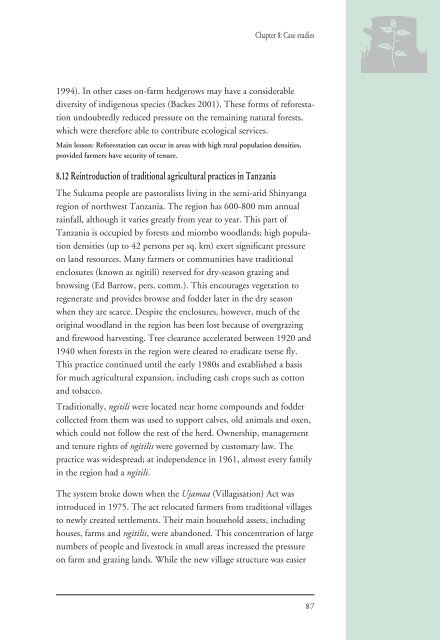Rehabilitation and Restoration Of Degraded Forests (PDF) - IUCN
Rehabilitation and Restoration Of Degraded Forests (PDF) - IUCN
Rehabilitation and Restoration Of Degraded Forests (PDF) - IUCN
Create successful ePaper yourself
Turn your PDF publications into a flip-book with our unique Google optimized e-Paper software.
Chapter 8: Case studies<br />
1994). In other cases on-farm hedgerows may have a considerable<br />
diversity of indigenous species (Backes 2001). These forms of reforestation<br />
undoubtedly reduced pressure on the remaining natural forests,<br />
which were therefore able to contribute ecological services.<br />
Main lesson: Reforestation can occur in areas with high rural population densities,<br />
provided farmers have security of tenure.<br />
8.12 Reintroduction of traditional agricultural practices in Tanzania<br />
The Sukuma people are pastoralists living in the semi-arid Shinyanga<br />
region of northwest Tanzania. The region has 600-800 mm annual<br />
rainfall, although it varies greatly from year to year. This part of<br />
Tanzania is occupied by forests <strong>and</strong> miombo woodl<strong>and</strong>s; high population<br />
densities (up to 42 persons per sq. km) exert significant pressure<br />
on l<strong>and</strong> resources. Many farmers or communities have traditional<br />
enclosures (known as ngitili) reserved for dry-season grazing <strong>and</strong><br />
browsing (Ed Barrow, pers. comm.). This encourages vegetation to<br />
regenerate <strong>and</strong> provides browse <strong>and</strong> fodder later in the dry season<br />
when they are scarce. Despite the enclosures, however, much of the<br />
original woodl<strong>and</strong> in the region has been lost because of overgrazing<br />
<strong>and</strong> firewood harvesting. Tree clearance accelerated between 1920 <strong>and</strong><br />
1940 when forests in the region were cleared to eradicate tsetse fly.<br />
This practice continued until the early 1980s <strong>and</strong> established a basis<br />
for much agricultural expansion, including cash crops such as cotton<br />
<strong>and</strong> tobacco.<br />
Traditionally, ngitili were located near home compounds <strong>and</strong> fodder<br />
collected from them was used to support calves, old animals <strong>and</strong> oxen,<br />
which could not follow the rest of the herd. Ownership, management<br />
<strong>and</strong> tenure rights of ngitilis were governed by customary law. The<br />
practice was widespread; at independence in 1961, almost every family<br />
in the region had a ngitili.<br />
The system broke down when the Ujamaa (Villagisation) Act was<br />
introduced in 1975. The act relocated farmers from traditional villages<br />
to newly created settlements. Their main household assets, including<br />
houses, farms <strong>and</strong> ngitilis, were ab<strong>and</strong>oned. This concentration of large<br />
numbers of people <strong>and</strong> livestock in small areas increased the pressure<br />
on farm <strong>and</strong> grazing l<strong>and</strong>s. While the new village structure was easier<br />
87

















